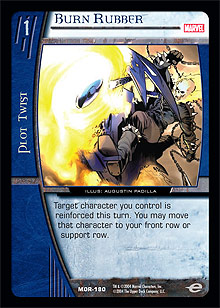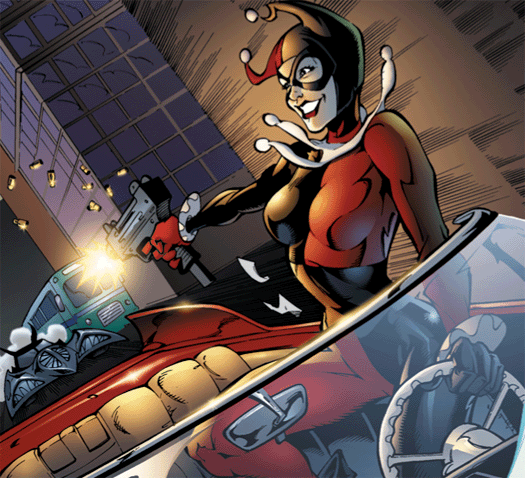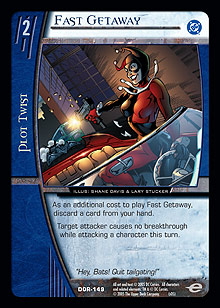
If you’re an avid Metagame.com reader or a frequent Vs. System player, you’re likely to know that July 1 will herald a big change for the game. The infinite recursion Rama-Tut combo will be removed from the environment by errata, and Overload will be banned from the Golden Age format.
It was a highly debated decision, but love it or hate it, it’s going to happen. As of July 1, Overload is hitting the dusty trail and we likely won’t see it again. This is going to result in a lot of shifts in high competition metagames. Like the banning itself, opinions vary wildly as to the potential metamorphosis of the global environment when this card is removed. Some theories seem a bit farfetched (“Wild Vomit, Back in the Hizzouse!” and whatnot), but there are a couple of assumptions that seem safe to make:
1. With the main weapon against Roy Harper ◊ Arsenal gone, Teen Titans will do better in the coming months.
2. With the ability to go crazy on combat modifiers, The New Brotherhood variants may be more reliable in their performances.
Both of these statements are justifiable and stem from the same root—removing the card that most severely punishes over-commitment to a single character will make fast decks more viable because they’ll be more difficult to disrupt. It’s a solid theory and a simple one, and therefore difficult to disrupt. So, in today’s article, I’ll use that as a base to discuss the Teen Titans and New Brotherhood metagame projections.
In an environment where more games may be won on turns 4 and 5 than ever before, reinforcement will become increasingly powerful. The previous deterrent from playing three Savage Beatdowns on a single attacker you control (Overload) has been removed, but players with a tendency to overextend will have to deal with a new pitfall: watching cards go to waste due to reinforcement. Reinforcement will become even more important than it was in the past strictly because it will be feasible for a player to swing with a 20+ ATK character on turn 4. When opponents start stacking the odds in their favor with a multitude of combat modifying plot twists, players need to fight back. That means either out-speeding the competition or having answers to huge attacks. Since comparative speed will be difficult to generate in an environment packed with fast decks, being ready to respond to a crushing attack will be the way to go; cards that prevent breakthrough will see their stock rise quickly in the minds of most players.  Burn Rubber will be the card to watch out for in this respect. It’s cheap, effective, and packs a nice little character-moving effect as a bonus, and it has driven decks like X-Stall to success in the past. It targets your own character and does not require its target to have the defender attribute, so it can be activated at any time. That makes it both a convenient and a cerebral play.
Burn Rubber will be the card to watch out for in this respect. It’s cheap, effective, and packs a nice little character-moving effect as a bonus, and it has driven decks like X-Stall to success in the past. It targets your own character and does not require its target to have the defender attribute, so it can be activated at any time. That makes it both a convenient and a cerebral play.
There’s always a drawback, and in this case, there are two. The first is the existence of Not So Fast and Detective Work, both of which prey on Burn Rubber’s cost of 1. Both can negate the important reinforcement you’re counting on, and the odds of having another Burn at your disposal are slim for most decks.
Second, cards like Blind Sided, Juggernaut, and Ant Man cut through Rubber’s reinforcement like a warm knife through butter. In the Vs. System, the forbidding of an action or state takes precedence for the turn over the establishment of such, so regardless of when Burn Rubber is used, a card like Blind Sided can stymie it. That’s bad news, considering how easily Blind Sided can fit into TNB.
The good news is that both of these problems are prevented through the use of Fast Getaway. What has always looked like an overpriced Burn Rubber is now set to come into its own, and though it costs a discard to use, it cleaves in twain the Rubber’s two weaknesses.

 Fast Getaway cannot be negated by Not So Fast or Detective Work because of its cost—its threshold of 2 instead of Rubber’s 1 places it outside the range of Spider-Man’s meddling webs and Batman’s constant snooping. This is especially valuable if the metagame you’re competing in has seen its share of Burn Rubber, as players will be using Not So Fast already and will find it less effective against you than they were hoping it would be. Forcing an opponent to hold dead cards is a good thing, and you can accomplish that with proper deck construction and tactics that render Not So Fast virtually useless.
Fast Getaway cannot be negated by Not So Fast or Detective Work because of its cost—its threshold of 2 instead of Rubber’s 1 places it outside the range of Spider-Man’s meddling webs and Batman’s constant snooping. This is especially valuable if the metagame you’re competing in has seen its share of Burn Rubber, as players will be using Not So Fast already and will find it less effective against you than they were hoping it would be. Forcing an opponent to hold dead cards is a good thing, and you can accomplish that with proper deck construction and tactics that render Not So Fast virtually useless.
The second and slightly more intricate piece of the puzzle is how Fast Getaway targets. It removes the ability to cause breakthrough from an opponent’s attacker (only while attacking a character) instead of applying the reinforced state to one of yours. That means that opponents can Blind Sided or Ant Man all they like; the fact that your defender cannot be reinforced is completely moot. What matters is that the attacker can no longer hammer endurance loss through your characters, and this is significant because it can only be prevented by rare effects like The Manhunters are a Myth. Once you understand the differences, it becomes an easy numbers game. How many copies of Blindsided and Not So Fast do you expect to see compared to the number of Myths? Pretty easy decision when it’s phrased that way, huh?
Of course, Fast Getaway offers some other interesting factors, as well. An attacker met with Burn Rubber could ready and maintain its ability to attack and cause breakthrough to another character if the attacker in question was aided by a source of direct stun. Don’t like the fact that Puppet Master hopped on his hog and beefed it to safety to cut off a big source of damage? Go ahead and have Terra blast him to bits. Your attacker readies, and while you lose any combat pumps you gave it, it can still attempt to put its fist through a different little guy. On the other hand, if Puppet Master took the hit but received some covering volleys via Fast Getaway, the opponent’s attacker is hurt for the entire turn—it can still attack and stun, but not cause breakthrough.
This is also relevant for cards that can attack more than once in a single turn, especially Quicksilver, Speed Demon. With combat pumps being easier to use in post–July 1 metagames, decks like Big Brotherhood that focus on raw stat modifiers suddenly become more viable. If you see Lost City a lot over the coming months, Fast Getaway will be an especially good choice.
Unfortunately, the associated cost with activating Fast Getaway can be daunting. Discarding a card is a serious investment. What you have to keep in mind, though, is that when you’re using Fast Getaway, you’re doing so to save yourself from relatively dire straits (either to get out of them or to make sure that you never reach that point of desperation). In short, losing a card is one thing and losing a game is another—both are bad, but hey, there’s a definite issue of scale. Fast Getaway’s costs means that it is not to be used lightly, but you wouldn’t regardless because you want to make sure that you get the most out of its effect when you play it. A surprising card like this, when played correctly even once, can completely lay waste to an opponent’s plans.
While Fast Getaway can be useful in any matchup, it’s going to work best against fast decks that need to hit hard. Losing a single card against an early game deck isn’t necessarily as damaging as losing one to a curve-based deck. Just getting to the late game puts these decks at a natural disadvantage due to their construction, and the discard costs of pricey effects are mitigated over the course of the entire game.
It needs some care, but Getaway can easily reward intelligent play and shrewd decision making. I’m not one to overestimate my reach—I think Burn Rubber is going to see a lot more play than Fast Getaway once the ban is implemented. But once players start teching against it with Not So Fast, Blind Sided, and other answers (which might happen immediately), a player using Fast Getaway instead of Rubber is going to have a distinct advantage in the field.
Odds are good that unless you’re Jeremy Gray, your Fast Getaways are covered in a thick layer of dust. Get ready to brush them off. As of July 1, they will definitely deserve to see the light of play.
-Jason Grabher-Meyer
Are you a champion of an obscure, underplayed card? Do you feel that it deserves some respect and is legitimately underappreciated? Let me know about it by sending me an email to jason@metagame.com!